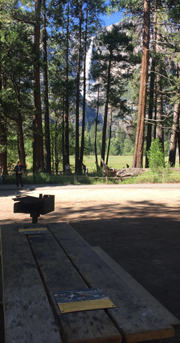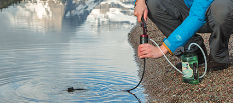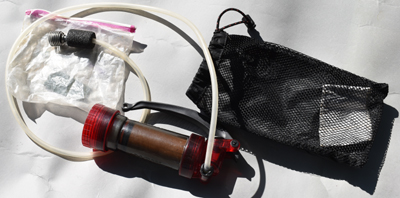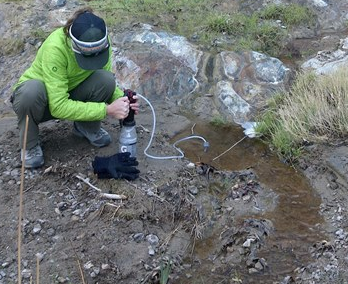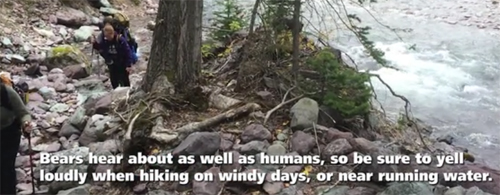Even when water is clear and sparking it needs to be purified, as Cryptosporidium and Giardia can be found in most waterways,
so you can’t just dip your water bottle in that crystalline stream.
The best way to have enough clean water when you hike is to carry it with you.
– You might expect to be able to filter water and not find any available to be filtered.
Please note that some campgrounds do not have safe, pure water and be careful of forgetting that and brushing your teeth at the sink.
Parks have many picnic areas with tables, grills and accessible vault toilets, but you must bring your own water or purify some from the river / lake.
For example, this riverside picnic area in Yosemite with views through the trees of Yosemite Falls (get to it via free shuttle bus stop number 7).
There are many ways to purify water. This webpage is not complete information, and we advise going to the Centers for Disease Control and Prevention (CDC) webpages linked to here for the most up-to-date advice.
Here are the basics:
The Centers for Disease Control and Prevention (CDC) says:
“Boiling can be used as a pathogen reduction method that should kill all pathogens. Water should be brought to a rolling boil for 1 minute. At altitudes greater than 6,562 feet (greater than 2000 meters), you should boil water for 3 minutes.”
If you choose to use boiling as your method, you might want to pour the water through a coffee filter first to remove particles. And be careful where you put the pan of water while it cools, as waiting-foreeeeever-for-it-to-cool and having it accidentally get knocked over and emptied is almost a tragedy.
You can also use bleach, but not scented: https://www.epa.gov/ground-water-and-drinking-water/emergency-disinfection-drinking-water
At REI we read:
Water filters work by physically straining out protozoan cysts (such as Cryptosporidium and Giardia lamblia) and bacteria (such as E. coli, Salmonella, Campylobacter and Shigella). These biological pathogens are the main water concerns if you’re traveling in the U.S. and Canada.
Water purifiers also combat viruses, which are too tiny for most filters to effectively catch. If you’re traveling in less-developed areas of the world, consider products that also provide protection for viruses (such as hepatitis A, rotavirus and norovirus).
But many National Parks are more recently recommending water purifiers, not just water filters: “Use a purifier rated to remove viruses. Check your filter or purifier carefully to understand what it is designed to remove.”
We do not use iodine tablets for Outdoor Club trips or for our own personal use.
Iodine can take a half hour to more than four hours to work and imparts a chemical taste.
The Centers for Disease Control (CDC) says: “Water that has been disinfected with iodine is NOT recommended for pregnant women, people with thyroid problems, those with known hypersensitivity to iodine, or continuous use for more than a few weeks at a time.”
Some places that sell various tablets will say: “Caution: Iodine is not effective against Cryptosporidium.” But not all products spell that out.
“Approved for military use” actually does not say anything about the effectiveness of a given product, but a young man on an Outdoor Club trip who believed it does, debated it with people for days.
Hydration packs or water filters that require you drink from a straw are not a good idea to share among people, as you risk getting germs from others making you sick or even causing a mouth infection.
https://www.cdc.gov/healthywater/drinking/travel/backcountry_water_treatment.html
The National Park Service had these notes about purifying water:
“The first step in the process is to collect the water you will drink. Here are some tips on how to safely collect water from a natural source:
Start with a clean container that preferably has been disinfected prior to use.
Wash your hands with soap and water or use hand sanitizer before collecting water so you don’t contaminate it.
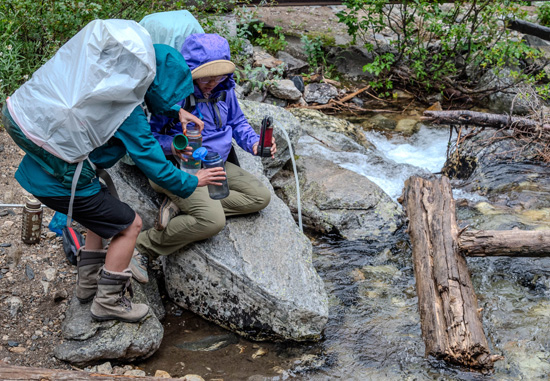
Choose a collection spot that is:
On higher elevations or near the water’s source
Away from established campsites
Away from animal grazing areas.
Collect water from areas of moving water in rivers and streams, or the top few inches of a lake. Stagnant (standing or non-moving) water is a breeding ground for insects, bacteria and viruses and should be avoided.”
The end of the pump hose that goes into the water source (lake, stream, etc. might have a small flotation device on it to keep it from going to the bottom and sucking up mud, sand or gravel:
When we put our filter pump back into the mesh drawstring bag after each use, we put the wet (dirty) hose end into a zip lock bag to keep other things in our pack from getting wet.
In shallow water you will need at least that flotation device, or might put the intake on a small rock to keep it out of the mud. (She is pumping from a tiny creek that comes out from a spring.)
Some pumps have ends that you can screw onto many brands of screw-top water bottles to make the bottles and pump easier to use when you can’t get conveniently close to the water source: (photo taken in Cascade Canyon, Grand Teton National park).
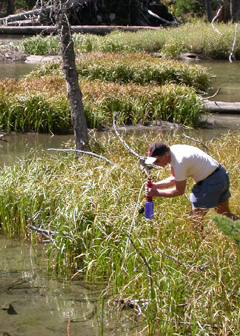
If you have the chore of pumping a lot of water for the group on an overnight, you can often find a place next to lakes we camp at with a view:
(photo taken at Leigh Lake, Grand Teton National park).
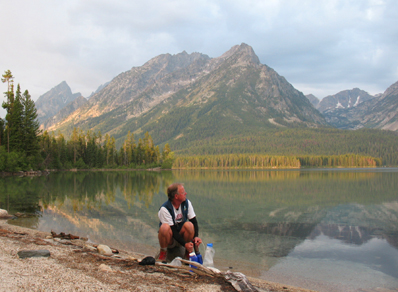
Please follow the manufacturer’s instructions of how often to backwash / clean the pump. Keep a copy of the instructions where you can find it. We suggest not keeping the directions booklet in the mesh drawstring bag the pump itself is carried around in, as it will leak on and soak the paper booklet. If you have your own water purifying pump, it will be much easier to back-wash it and/or take it apart and clean the exterior of the filter cartridge at home before the trip, than waiting until the trip when it starts to not work well.
You can purify water to kill most microbes, but you can’t remove other contaminants such as heavy metals, salts and most other chemicals. Because water purifying hand pumps can’t remove chemicals, they can’t clean up flood water floating in/around people’s homes after a hurricane for drinking, and boiling such water also will not make floodwater safe for human consumption. See also: store water for after an earthquake
Because it is time consuming to purify water (or heavy to carry enough),
some backcountry travelers choose to not drink enough water.
But dehydration can weaken you or even kill you.
The Red Cross says:
The best prevention strategy for heat-related illnesses is to stay properly hydrated. Staying hydrated helps to make sure fluids lost through sweating are replaced, which helps to reduce the risk for experiencing a heat-related illness. Water is the best choice of fluid for staying hydrated. Drink a few ounces every 15 to 20 minutes or however much you need to not feel thirsty.
Devil’s Postpile National Park put this chart up in restrooms for people to help them determine when they are dehydrated and need to drink more water:
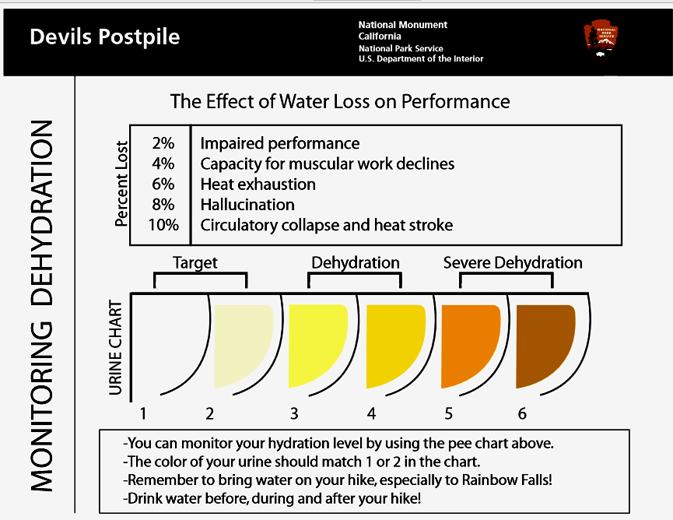
The National Park Service often warns hikers :
“Avoid becoming dehydrated or experiencing heat exhaustion. Drink plenty and drink often; pace yourself; rest in the shade; eat salty snacks.”
“Replace sodium lost through sweat by supplementing your water intake frequently with salty, easily digested snacks, such as trail mix or nuts.”
Avoid salt tablets, as they can irritate your stomach and cause nausea and/or vomiting, can raise blood pressure, cause stomach ulcers, and seriously affect people with heart disease.
Yosemite Search and Rescue Ranger John Dill wrote:
“No Yosemite climber has died from heat, but a half-dozen parties have come close. Too exhausted to move, they survived only because death by drying-up is a relatively slow process, allowing rescuers time to get there.
Temperatures on the sunny walls often exceed 100° Fahrenheit, but even in cool weather, climbing all day requires lots of water.
The generally accepted minimum, two quarts per person per day, is just that – a minimum. It may not replace what you use, so don’t let the desire for a light haul bag be your overriding concern, and take extra for unanticipated delays. Do not put all your water in a single container, and watch out for leaks.
If you find yourself rationing water, remember that dehydration will seriously sap your strength, slowing you even further. It’s not uncommon to go from mere thirst to a complete standstill in a single day. Continuing up might be the right choice but several climbers have said, “I should have gone down while I could.”
At Have more fun camping you can learn how to build campfires that don’t smoke too much, how to pack an ice chest (cooler), do dishes in camp and lots more.
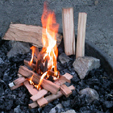
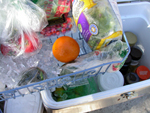
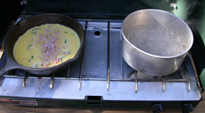
There are no restrooms or pit toilets along many trails, even near developed areas, in parks. You should be prepared to “urinate at least 200 feet from streams and lakes. To prevent contamination of waterways, bury feces in a hole 6-8 inches deep at least 200 feet from streams and lakes. Pack out” (do not bury or burn) “used toilet paper,” etc.
How to poop in the woods. has details.
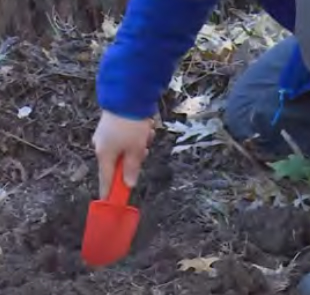
While hiking talk loudly, sing, shout, clap hands or otherwise make noise on the trail (‘bear bells’ do not work)
The NPS says:
“When hiking, periodically yell “Hey bear!” to alert bears to your presence, especially when walking through dense vegetation/blind spots, traveling upwind, near loud streams, or on windy days. Avoid thick brush whenever possible.”
“Bear bells may be a popular item to put on your backpack, but they don’t effectively warn a bear you’re in the area. Bears won’t hear the bells until you’re too close. Yelling, clapping, and talking are more effective ways of alerting a bear to your presence.”
See more at bears.
The author of this webpage, (written as a reading assignment for my students), does not give any warranty, expressed or implied, nor assume any legal liability or responsibility for the accuracy, completeness, or usefulness of any information, product, or process included in this website or at websites linked to or from it. Users of information from this website assume all liability arising from such use.
